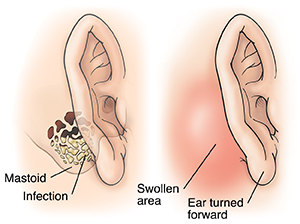Your child has mastoiditis. This is an infection of the mastoid—he hard, bony area located right behind the ear. It's most often the result of an infection that started in the middle ear and spread to the bone.
Who is at risk for mastoiditis?
Mastoiditis is more common in children than adults. Having any of the following may make getting it more likely:
-
An ear infection
-
Eustachian tube problems
-
A problem with the immune system
What are the symptoms of mastoiditis?
-
Fever
-
Ear pain
-
Swelling over the mastoid bone (bone behind the ear), causing the ear to turn forward
-
Redness, tenderness, or swelling behind the ear
-
Drainage from the ear canal or dizziness
-
Weakened facial muscles (uncommon)
How is mastoiditis diagnosed?
Your child’s healthcare provider will ask about your child’s medical history. They will also do a physical exam. This helps find the best treatment. An imaging test such as CT scan or MRI may be done to help the healthcare provider make a diagnosis and view the mastoid area.
How is mastoiditis treated?
If mastoiditis is suspected, your child may be admitted into the hospital for evaluation and treatment. The hospital stay can last for
Long-term concerns
Once treated, the mastoid often causes no long-term problems. But if left untreated, mastoiditis can lead to a serious infection in and around the brain. To protect your child’s health, follow up with their regular healthcare provider.


